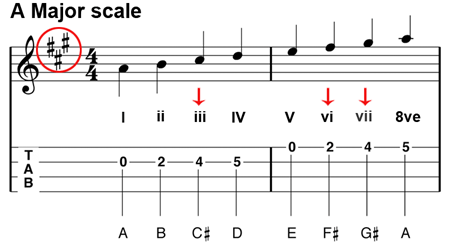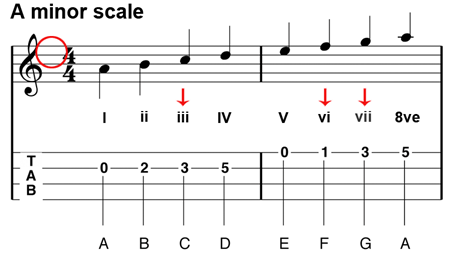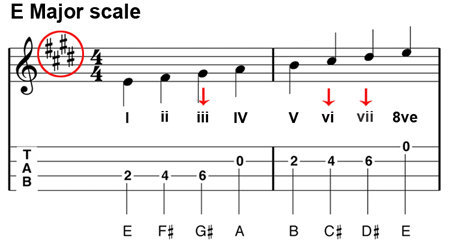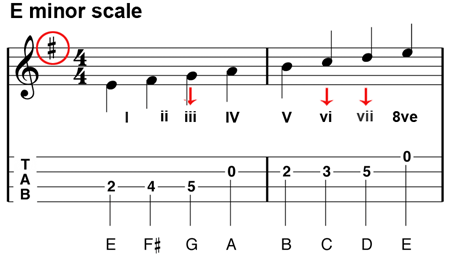A Parallel Universe
You may ask, “what changes need to be made to the Major scale to turn it into a minor scale”?
Or , how does the minor scale differ from the Major scale?
Let’s look at the A Major scale:
A Major
A – B – C# – D – E – F# – G# – A
Here is the mandolin tab for the A Major scale. Play it a few times, and notice where the 3rd, 6th and 7th notes end up under your fingers.

As a result, if we flat the 3rd, 6th and 7th of the A-Major scale – C# becomes C natural, F# becomes F natural, and the G# becomes G natural.
We end up with the A-minor scale.
A minor
A – B – C – D – E – F – G – A
Here’s what it looks like on your mandolin. Note where the changes took place.

As you can see, the notes have changed and the two scales have different key signatures in the musical notation (see red circle). But, they have the same tonic (they start on the same note).
And that’s all there is to it!
We can turn any Major scale into a minor scale by flatting the 3rd, the 6th and the 7th degrees.
Let’s try another! Here’s the E Major scale:
E Major scale
E – F# – G# – A – B – C# – D# – E
Again, I’ll show you the tab so you can play it on your mandolin.

In order to change it into an Em scale we need to flat the 3rd, 6th and 7th.
And here’s what we get:
E minor scale
E – F# – G – A – B – C – D – E

As I mentioned before, the two scales do not contain the same notes, so they have different key signatures. But, they have the same tonic. The only real relationship they share is that they both start with E. They have the same tonal center. It’s like two people that are unrelated but have the same name.
Which explains another minor term.
When a minor scale has the same tonic as a Major scale, we say its that Major scale’s parallel minor.
For instance:
- E-minor is the parallel minor of E Major
- A-minor is the parallel minor of A Major
- The parallel minor of Bb Major is Bb-minor
- etc…
The parallel minor uses different notes than it’s parallel Major, but it has the same tonic. It starts on the same note.
However, the name ‘parallel minor’ is only in reference to the Major scale with which it shares a tonic (it’s parallel Major). It is still a natural minor scale.
The sum of differences
In conclusion, and to sum it all up, we’ve looked at 3 different ways to find the ‘natural minor’ scale.
- the relative minor method – (start on the 6th tone of any Major scale)
- and the natural minor formula – (W-H-W-W-H-W-W)
- the parallel minor method – (flat the 3rd, 6th and 7th tone of the Major scale)
Here is a list of all the Major Keys and their Parallel and Relative minors:

Harmonic and Melodic minor scales
The harmonic minor and melodic minor scales are both derived from the natural minor. I don’t want you to worry about them too much at this point.
However, once you become fairly confident with the minor scale, you may find it interesting to explore them a little further. So, I’ll show you what they are, how they sound, and how they’re constructed.
The Harmonic minor
The harmonic minor is exactly the same as the natural minor, except the 7th degree is raised a half tone (semitone).
Here is the tab:

By raising the 7th a half tone, you create an interval of 3 semitones (augmented second) between the 6th and 7th scale degrees. When you play it, that leap between the 6th and 7th creates a very unique and interesting sound. It definitely has an Eastern flavor to it, when you play it as an ascending and descending scale.
Although not nearly as common as the natural minor, the harmonic minor can be found in all genres.
If you’re interested in more info on the harmonic minor, check out this video
The Melodic minor
When compared to the natural minor, the melodic minor has a raised 7th, just like the harmonic minor. But, the 6th is also raised a half step to eliminate that augmented second between the 6th and 7th scale tones. At this point, it only differs from its parallel Major by a flatted third (that minor sound). However, that is only when ascending. When the scale descends, the melodic minor is exactly the same as the natural minor.
Here is the tab:

By raising the 6th along with the 7th, the melodic minor is thought to create smoother melodies by eliminating that 3-semitone leap. It can be heard in classical compositions and jazz. But, just like the harmonic minor, it is possible to find examples of this scale in most genres.
If you are interested in more info on the melodic minor, check out this video.
Work on it!
Well, that’s a short burst through the minor scales, and I hope you found something of interest.
Playing scales is the best way to become familiar with them. As you probably know, scales, scale fragments and patterns are used in composition and improvisation. Moreover, practicing scales is also a great way to work on your timing, dexterity and tone.
If you would like practice tab for some of the more common minor scales, just click on the link below. If you’re interested in the less common keys, now you know how to figure them out.
Download:

